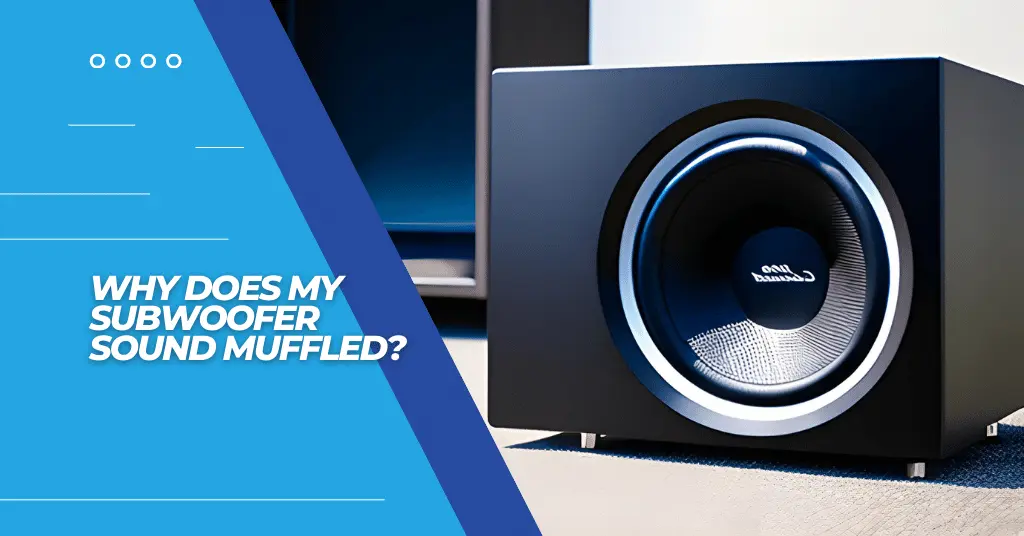Why Does My Subwoofer Sound Muffled?

I’m 100% sure that you’re looking for a solution to your muffled subwoofer sound. Well! This issue can frustrate many audiophiles, making it difficult to get the most out of their music.
Fortunately, I’ve got your back as I’ll share all the possible reasons behind such muddy sounds from the subwoofer. In today’s article, I will examine what causes a muffled sound from your subwoofer and how you can fix it.
I will also discuss the importance of setting up your equipment correctly and explain why having clean cables is essential for good sound quality. Let’s dive in!
What Are the Common Causes Behind Muffled Subwoofer Sound?
According to my whole career, I have been able to find the following reasons that may cause the muffled sound from your subwoofer:
1. Incorrect Phase Settings:

This is the most essential part of any good sound system. Phase settings are the timing relationship between different speakers in a sound system, and they play a crucial role in setting up your subwoofer.
When you set it incorrectly, out-of-phase signals can interfere with one another and cancel each other’s bass frequencies. As a result, you’ll get a poorer audio quality, weaker bass output, dulled mid-range sounds, or an overall muffled sound that lacks definition. Basically, your sound system’s phase knob must be at 0 or 180 degree.
How to Adjust the Phase Settings for Better Sound?
Why don’t you give it a try flipping the phase switch for once? However, it’s really essential to have a rightly-set phase setting for your audio system.
Simply, you can do this by flipping the phase switch on the back of your subwoofer or using a polarity test meter or app. Doing so will reduce interference and eliminate errors for better audio performance.
2. Inadequate Power Supply:

The insufficient power supply can also be a culprit for a terrible subwoofer sound (found in many cases). An inadequate power supply to a subwoofer can profoundly affect the speaker’s performance and result in a muffled sound.
An insufficient power source will not allow the subwoofer to reach its full potential. It may not be able to reproduce low frequencies as loudly or accurately as it should, which leads to distortion and what sounds like a muffled audio quality.
How to Correct the Inadequate Power Supply For Better Sound?
Here’s what you can do! The first step to correcting an inadequate power supply is to ensure that your power source meets or exceeds the requirements (but not too much) for your specific make and model of the subwoofer.
Suppose it doesn’t consider upgrading the power outlet or investing in a separate power amplifier. Then check if your audio amplifier has enough watts for your system’s needs so both components are adequately powered.
In some cases, a dedicated outlet can provide more efficient current delivery and help reduce potential interference issues while providing adequate output at lower distortion levels.
3. Incorrect Crossover Settings:
Yeah! This can be a big reason behind such an unpleasure experience. Crossover settings are used to determine the frequency range of a subwoofer.
If the phase settings are incorrect or misconfigured, it can cause the subwoofer to produce a muffled sound. This happens because either you limit the subwoofer’s range too much or enable frequencies that it cannot handle effectively.
As a result, the sound will be cut off prematurely, lose its depth and clarity, and generally become muddled due to incorrect crossover settings.
Furthermore, if too much power is sent to specific frequencies than what the woofers can handle due to incorrect crossover settings, it can damage them and cause distortion and muffling of their sound output.
How to Adjust the Crossover Settings For Better Sound?
To ensure optimal performance of the subwoofer, you must carefully adjust its crossover settings and ensure that they are not overloading it beyond what it can handle regarding power output.
This way, maximum sound quality is achieved without distortion or damage to components within the system.

4. Improper Equalization Settings:
Equalizers are a great way to shape your subwoofer’s sound and get the most out of it. However, incorrect settings or inappropriate audio processing can produce a muffled bass sound.
Poor equalization could lead to an overly bassy or muddy sound that is not balanced with the highs and mids. This could mean either too much low end is present, muddying up your mix, or you might have cut too many frequencies from your subwoofer and ended up having a thin-sounding bottom end.
How to Set EQ Settings to Eliminate the Muffled Sound?

Using equalizers or audio processing features is essential when attempting to get the best subwoofer sound possible. To eliminate this issue, I advise users to regularly check their equalization and audio processing settings and adjust them to achieve an ideal balance of high-end clarity and low-end punchiness.
The careful trial will also help users achieve desired results in terms of sound quality. Remember – properly using equalizer settings will go a long way toward enhancing your subwoofer performance!
5. Poor Signal Connection:
Having secure and proper signal connections is essential to have the best sound for your subwoofer. If these connections are loose or faulty, you will experience a loss in signal strength, leading to poorer performance.
This can damage audio quality, with it often sounding muffled. The poor signal connection can also cause electrical interference, which hinders the standard transmission of signals from one device to another resulting in unwanted noise.
Here’s my little advice! To prevent this, you must ensure that any cables and terminals are securely fitted and regularly checked for damage or corrosion.
A secure connection provides optimal subwoofer performance, providing unparalleled sound clarity and punchy bass response.
6. Enclosure Issues:

Many audiophiles fail to understand the right enclosure size and type! They don’t even know enclosures can either make your sound system powerful or make it worst. Subwoofer enclosures play an essential role in the quality of bass sound.
A suitable subwoofer enclosure is designed to provide a tight, distortion-free bass that compliments the main speakers. Poorly designed or damaged boxes can cause distortions and muffled bass due to inadequate damping materials or incorrect air volume inside the box.
How to Address Subwoofer Enclosure Issues?
The best way to address subwoofer enclosure issues is to ensure they are correctly designed and built. This means using suitable materials, such as damping materials and air volume inside the box, and ensuring they are properly sealed to avoid distortions.
Additionally, proper placement of the woofer should be considered, both in terms of distance from walls and angles, for optimal sound performance.
7. Mismatched Impedance Ratings:
Please read it carefully! Mismatched impedance ratings between the subwoofer and amplifier can be a significant reason for a muffled sound.
When the output of an amplifier does not match the input impedance of single or multiple drivers, you may experience poor sound quality.
This is because there is an imbalance in power between one or more components that reduce their overall efficiency—the result: is distortion and diminished performance, resulting in muffled subwoofer sound.
How to Match the Impedance Ratings Between Subwoofer & Amp?
To ensure optimal sound quality from your subwoofer, you must match the impedance rating of both components. The output of an amplifier must be equal to or greater than the input impedance of single or multiple drivers.
To achieve this, you can use either speaker with higher wattage ratings than those supported by the amp or reduce the load on each speaker using parallel wired connections.
8. Speaker Wire Issues:
Yup! Wiring issue may sound like nothing. But speaker wires play an essential role in the sound quality of subwoofers. If the speaker wire is poor quality or damaged, it can lead to signal loss or interference, resulting in a muffled sound from your subwoofer.
The source of distortion may be due to too much resistance within the length of the wire, impurities that disrupt current flow, and faulty connections or corrosion at either end.
How to Make the Good Speaker Wiring to Eliminate the Muffled Sound?
Here’s what I think! To achieve maximum performance from your system, use high-quality speaker cables without wear and tear; otherwise, you’ll hear crackles, pops, and muffled bass tones.
Additionally, ensure all connections are secure within any audio outlet to avoid potential problems such as short-circuiting that can strain amplifiers and cause distorted audio output.
9. Room Size and Acoustics:
The size and acoustic properties of the room can play a significant role in determining how your subwoofer sounds. A small room or one with poor acoustics can cause reflections and resonances that result in inefficient sound dispersion.
This leads to an overall muffled sound, as some frequencies will be overemphasized while others are diminished. Additionally, bass waves can bounce off walls instead of being absorbed by them, leading to muddy low notes and bloated bass.
What Should You Do About Room Acoustics For Better Sound?
To resolve this issue, you should opt for a larger room with treated walls that absorb most high-frequency reverberations for more precise audio reproduction.
The proper placement is also crucial to ensure adequate sound absorption across all frequencies, ultimately giving you optimal performance from your subwoofer speakers.
10. Subwoofer Aging or Wear:
Subwoofers are essential components of any audio system, and like any other electronic device, they’re subject to wear and tear over time.
Over the years, features such as capacitors, components, and internal wiring can degrade due to age or excessive use. This can lead to a muffled sound coming from your subwoofer.
These worn-out components will dull the overall quality of the sound. If you want to resolve this issue, I recommend replacing these parts with fresh ones for optimal performance and maximum output from your subwoofer.
Additionally, ensure that you regularly maintain your subwoofer to minimize wear and tear from dirt buildup or other external factors that could affect its performance over time. Proper care should help extend the life of your beloved bass system!
What to Do if a Car Subwoofer Sounds Muffled?
If a car subwoofer sounds muffled, here are some steps you can follow to troubleshoot and address the issue:
- Check the subwoofer’s placement in your car and adjust it if necessary.
- Verify that all wiring connections of the subwoofer (power, ground, signal cables) are secure and robust.
- Inspect the enclosure for any physical damage or defects.
- Adjust settings on your car stereo or amplifier that control the subwoofer correctly – crossover settings, equalizer settings, bass settings, etc.,
- Test the power supply to ensure adequate power is delivered to your car from your car’s electrical system; consider upgrading it if needed.
- Carefully inspect the driver for visible signs of damage or wear; replace it if required.
- Consult a professional audio technician for expert guidance and tailored solutions if all else fails.
General FAQs
Why Does My Sub Sound Muddy?
The muddy sound usually means too many low frequencies in the mix, resulting in an unclear sound. Try adjusting the bass and treble settings to balance out your sub’s tonal range for a crisper sound. You may also need to check your room acoustics and any audio equipment you use.
How Can I Determine if My Subwoofer Driver Is Faulty?
Check for any signs of physical damage or corrosion to determine if your subwoofer driver is faulty. Next, listen for muted sound or static from it and check the connection wires for visibility of any breaks or shorts. If all else fails, use a multimeter to measure its resistance.
How Can I Make My Subwoofer Sound Quality Better?
You can make your subwoofer sound better by placing the speaker in an ideal spot, setting the crossover filter correctly, and using acoustic treatment to reduce distortion. Additionally, selecting a quality subwoofer with a good amplifier will ensure optimal sound quality.
